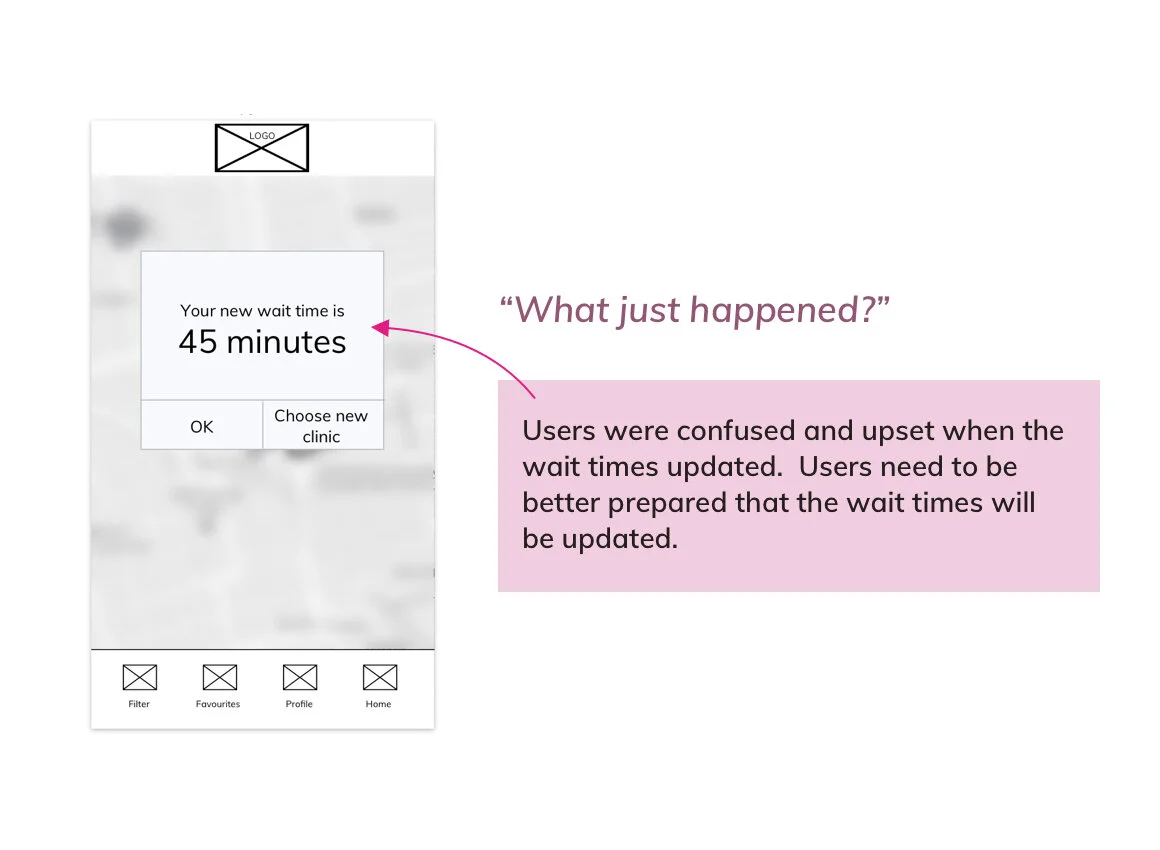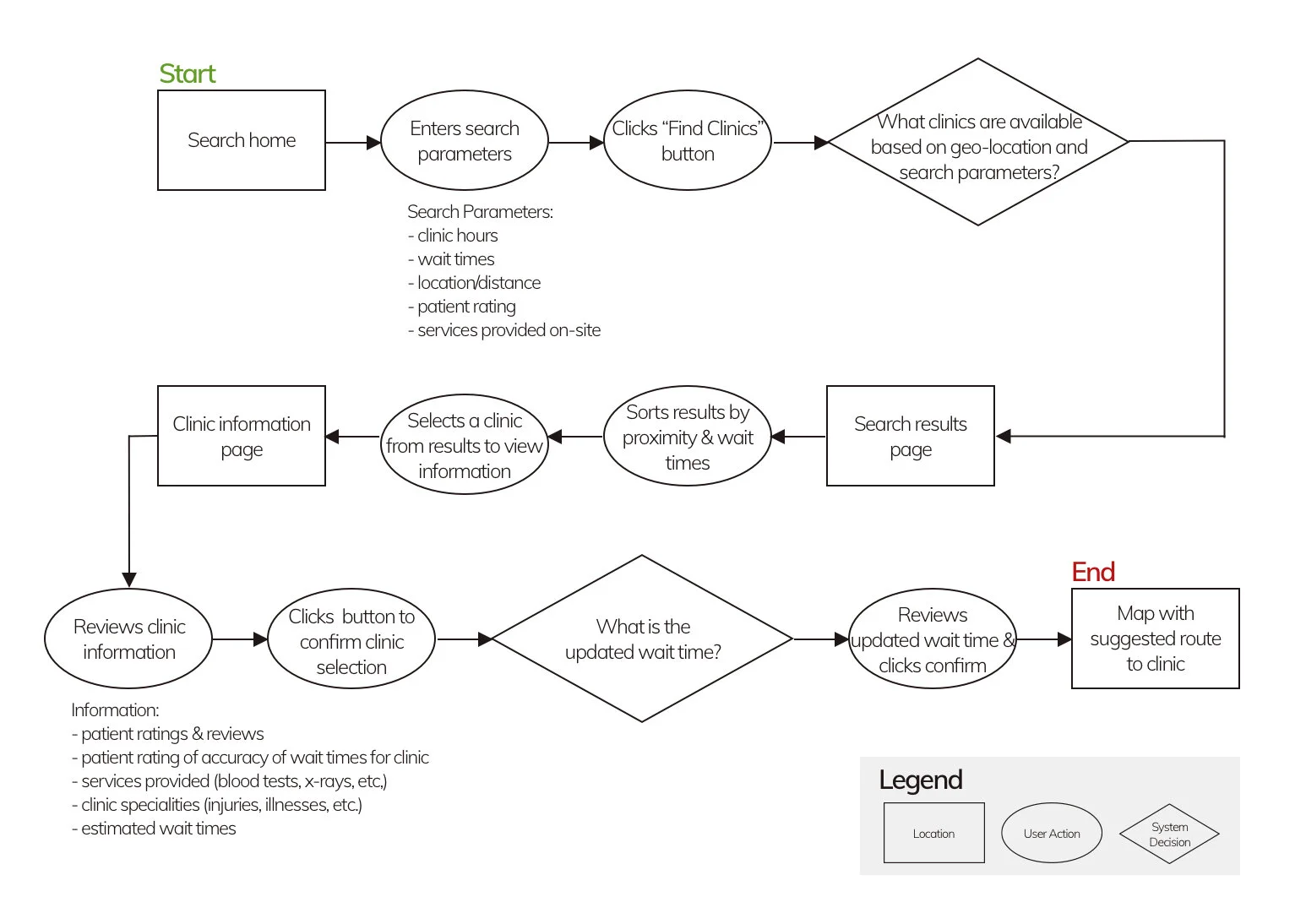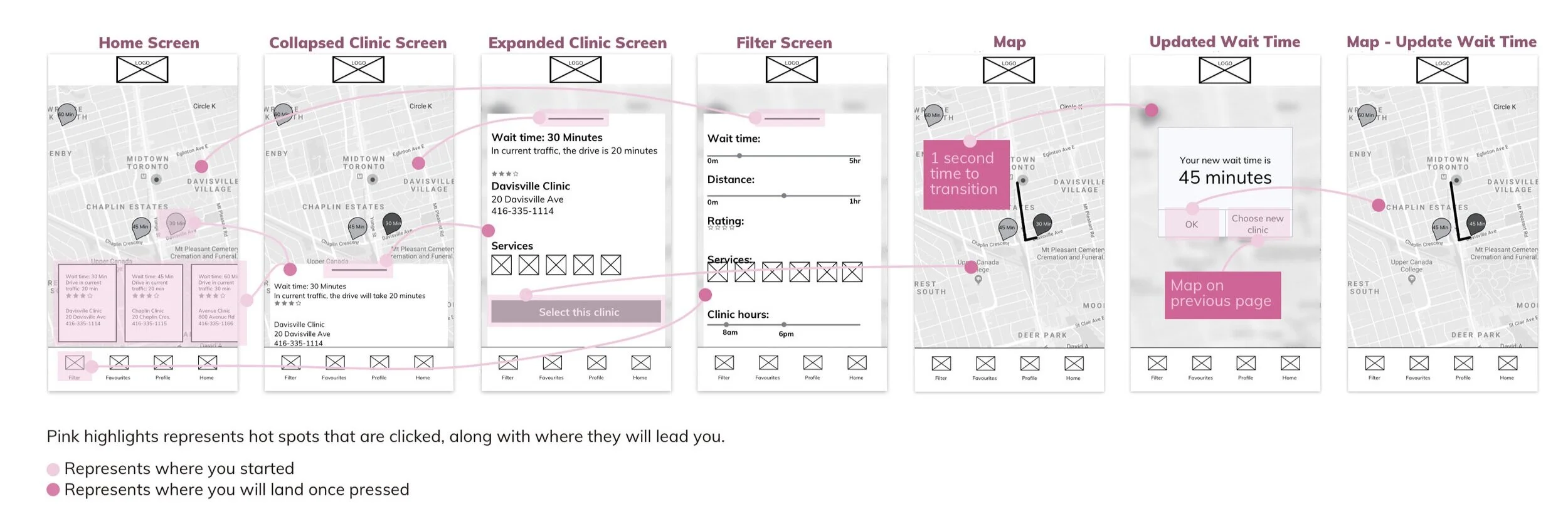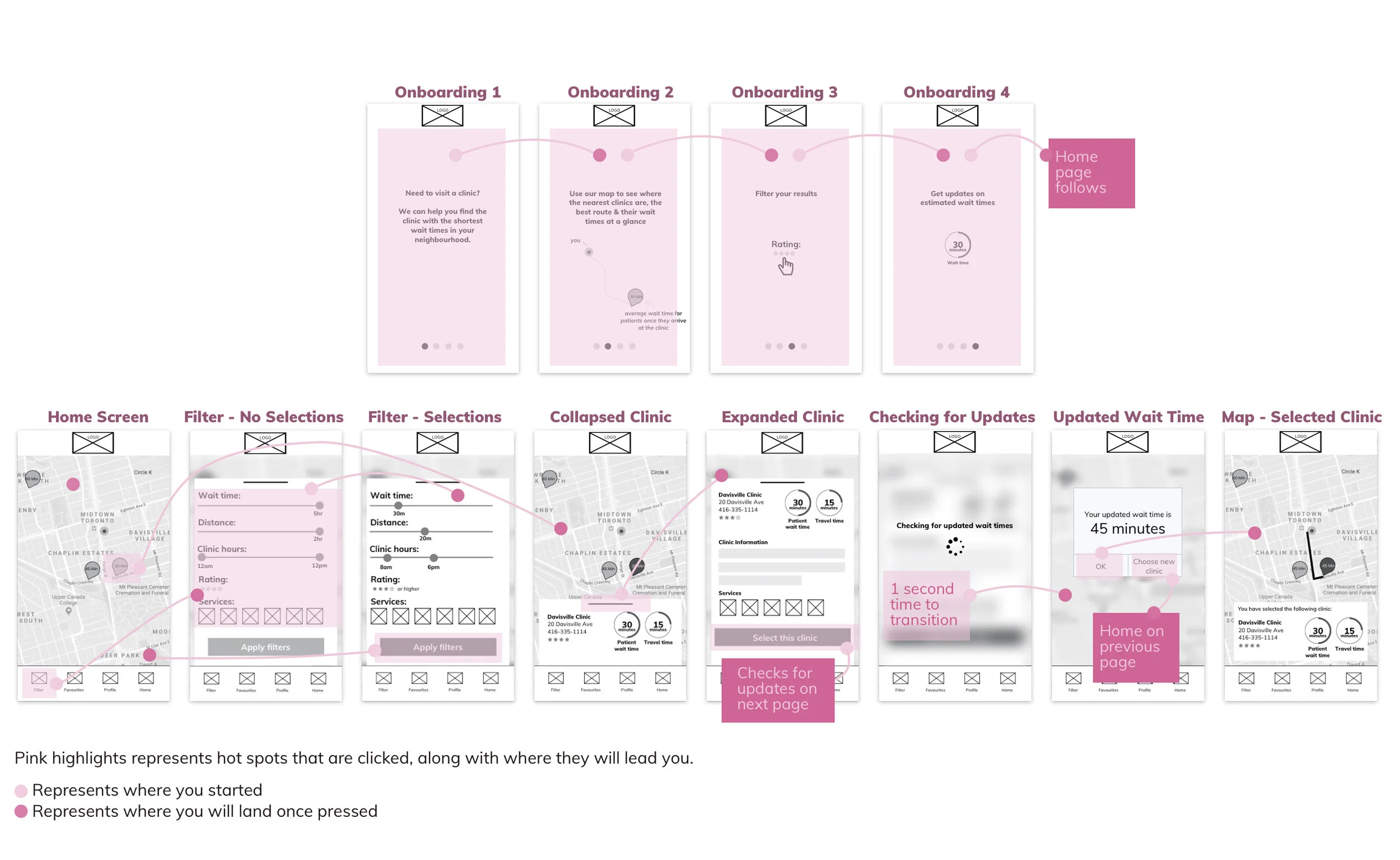Patients First
A UX Case Study
The Challenge
Provide Patients First, a government initiative, with a greater understanding of patients’ experiences, behaviours, pain points and opportunities in order to improve healthcare and future patient outcomes.
I started by conducting secondary research, to gain a greater understanding of the challenges and goals of patients. This allowed me to identify opportunities for improvement, and finally develop and test a low fidelity digital solution.
About the Project
Timeline: 2.5 weeks
Role: UX Designer & Researcher
Tools Used: Sketch, InVision
Platform: iOS
Design Solution
The digital solution that I developed and tested for Patients First, provides patients with the opportunity to search for clinics by distance and estimated wait times. The goal is to support good patient experiences, as well as promoting timely care and positive patient outcomes.
To view version 2 of the low fidelity Invision prototype, please click here.
Process Overview
The process for this case study began with clearly defining a specific problem space and opportunities through primary and secondary research. Following that, a series of sketches and three rounds of prototypes and tests followed.
Secondary Research Highlights
Healthcare is a space about which I know very little; as such, I started by conducting secondary research to develop a greater understanding of some of the pain points and challenges, as well the goals and motivations of patients. Here is a summary of the highlights:
Problem Space Identification
As a result of the preliminary secondary research, I found that when seeking medical attention, patients and their caregivers often select an inappropriate care provider or level of care. As a result, health care centres are overburdened and the patients that require care at those centres do not receive the level of care they need in a timely manner. Patients are frustrated by long wait times, hallway medicine and rushed attention from medical providers.
How Might We…
… proactively guide patients to the correct healthcare provider and/or centre so that they receive the right level of care for their condition?
Primary Research & Interview Insights
After identifying the problem space, I completed primary research in order to validate my findings and suppositions, from my secondary research. The following research objectives were defined:
Interview Participants
Four individuals were interviewed to learn about their motivations, actions and feelings with regards to seeking medical care.
Specific participant criteria was identified, to learn what health care providers/centres adults visit when they have access to both a primary care physician and alternate care, and how the acuity of their situation, as well as their knowledge of medical care options, impacts their choices.
Interview Participant Criteria:
Generally healthy
Age 18 - 70
Must have a primary care physician
Must have access to multiple avenues of care (primary care physician, hospital, clinics, Telehealth Ontario, etc.)
Must have sought unplanned medical care outside of primary care physician (e.g. a clinic or hospital) in the last 8 years
Interview Insights
As a result of the interviews, I gained the following insights:
Problem Space & How Might We Refinement
After performing user interviews, it was found that users generally preferred visiting their primary care physician, and only sought medical care elsewhere for urgent conditions. Their primary concerns related to convenience: proximity and wait times.
Updated: Problem Space
In order to better address the concerns identified via the primary research, the remainder of this study will focus on addressing the pain points identified in the second part of the problem space and user interviews:
“Health care providers/centres are overburdened and the patients that actually require care at those centres are not getting the level of care they need in a timely manner. Patients are frustrated by long wait times, hallway medicine and rushed attention from medical providers.”
Updated: How Might We…
Consequently, the remainder of this study, the following statement will be considered:
“How might we proactively guide patients with urgent medical conditions to healthcare providers and/or centres with the shortest wait times to ensure that all patient’s medical needs are treated as efficiently as possible?”
Patient Persona: Shannon Cooke
To reflect the research insights, the following patient persona was developed:
“I’d rather go to my primary care physician, but when I need urgent care I’ll visit a clinic or hospital. But there’s always a line up; I just want to be seen quickly and go home!”
Persona Biography
Shannon is experiencing a low acuity, but urgent medical issue and needs to visit a clinic, as her primary care physician is unavailable. She searched online, and while she was able to find clinic locations and times, Shannon is frustrated by the lack of information regarding how busy a clinic is and how quickly she will be able to receive treatment.
Goals
Seek medical consultation for a low acuity, but urgent medical issue quickly
Determine wait times for treatment before selecting a medical care centre
Frustrations
Shannon’s doctor’s office is closed for the day, as such she will need to seek an alternate medical care provider
Shannon does not often seek urgent medical care and she is not familiar with the care options available
She does not know which care option will be the fastest, most convenient or which will provide the best care
User Stories
To develop a greater understanding of Shannon’s needs, objectives and processes, I developed a series of user stories. A selection of user stories, which are addressed in the solution, are found below organised into epics.
As a patient seeking urgent medical care for a low acuity condition…
Epic: Selecting a Clinic
…I want to filter by services and treatments provided onsite , so that I can make a more informed decision based on my condition and more effectively self-triage.
…I want to filter clinics by location, so that I can select a clinic that is relatively close in proximity.
…I want to filter clinics by rating, so that I can see which clinics have had the best patient ratings.
…I want to sort clinics by wait time and distance, so that I can decide if I would be better to travel slightly further to a clinic with a shorter wait time.
…I want to see estimated wait times in real time, so that I can get a sense of how long it will take to be treated at different facilities.
…I want to see the time accuracy rating provided by other patients, so that I can validate that the estimated wait times are accurate.
Epic: Ratings & Reviews
…I want to be able to rate & review my experience regarding the care provided, so that it can help other perspective patients make decisions regarding where to seek treatment.
…I want to be able to favourite clinics and care providers with which I have had good experiences, so that next time I know where to go for trusted care.
…I want to rate the accuracy of the estimated wait time, so that the functionality of the product can be improved and other patients can make informed decisions of where to go for treatment.
Epic: Logistics
…I want to be advised of the best route to get to the clinic, so that I can get there quickly, in order to be treated quickly.
Task Flow: Clinic Selection
As a result of the user stories, I determined that the greatest opportunity was to design a task flow to support patients’ clinic selection. This task flow would allow patients needing urgent medical care for low acuity conditions to be pointed to an appropriate care facility with the shortest wait times.
Sketches & Idea Refinement
With the above task flow and objectives in mind, I researched existing patterns and designs for the various required elements of the digital solution. Using the research as inspiration, I sketched a variety of options, as seen below.
Crazy 8s
Sketches: Idea Refinement
Below are the sketches that leverage the best ideas from the crazy 8s exercise, shown above. These are the same sketches which were used in the POP prototype in order to complete the first round of user testing.
Insights: POP Testing
As a result of testing the paper prototype, the following updates were made when creating the digital wireframes in Sketch:
Digital Wireframes: Version 1
The following wireframes were created using Sketch, leveraging the hand drawn sketches as reference.
Usability Testing Highlights: Version 1
The above wireframes were used to perform usability testing in Invision. Below is a summary of three of the most significant concerns which were raised and addressed in the first round of user testing.



Digital Wireframes: Version 2
The wireframes were updated (see below) as a result of feedback from the usability testing of version 1.
Usability Testing Highlights: Version 2
After having updated the wireframes, I performed a second round of usability testing in Invision. Below is a summary of three of the most significant concerns which were raised in the second round of testing.



Final Thoughts & Future Opportunities
Over the course of this project, great strides were made to understand users needs and desires with regards to how they seek urgent, but low acuity medical care and how we might proactively guide Patients First users to the clinics with the shortest wait times in their vicinity, and away from other emergency centres that need to focus on higher acuity conditions.
While many insights have been gleaned from the research and testing, further iterations and testing are required to address the outlined concerns and recommendations resulting from the second round of testing.
During testing there was appetite for additional features; as such, the following task flows could be researched and prototyped for future iterations. In addition to meeting user wants and needs, these additional features would support the end goal of ensuring patients are treated quickly and efficiently:
Appointment bookings via the app for a future time
Registering with a clinic via the app before arrival
Providing real time directions with instructions












